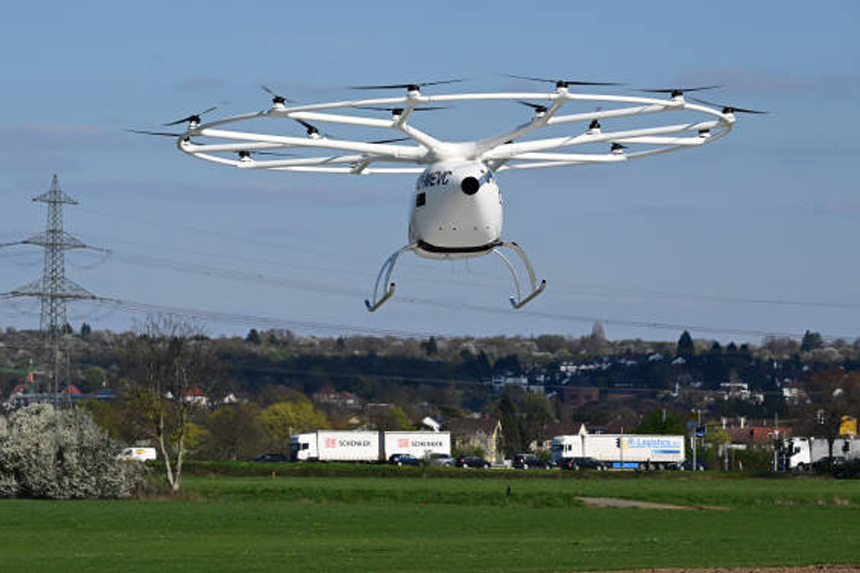Some of the top companies in the electric vertical takeoff and landing (eVTOL) sector need more financial support as the globe rushes toward a future full of electric flying taxis. The path to commercializing these futuristic aircraft is proving to be longer and more challenging than first anticipated. Companies like Volocopter, Lilium, and Vertical Aerospace face increasing challenges that endanger their future despite great promises and notable accomplishments.
Why Did Volocopter's Electric Taxi Dream Fail to Take Off?
One of the most much-awaited developments at the Paris Olympics was expected to be Volocopter’s electric-powered flying taxi fleet. The German company had stated that it’s two-seater VoloCity would be ferrying people throughout the city. Those dreams, meanwhile, were not realized. Volocopter can only do demonstration flights, disappointing many who had hoped for a full service.
Although the delay embarrassed me, behind the scenes, a far more urgent problem was developing. Volocopter was frantically trying to find new capital to help the business survive. Earlier in April, the company failed to borrow €100 million (£83 million; $106 million) from the German government.
Now, all hopes are focused on a possible agreement with China’s Geely, apparently in negotiations to purchase an 85% share in Volocopter for $95 million in investment. A Bloomberg story claims this agreement would move future industrial activities to China. Volocopter’s grandiose aspirations remain shadowed by doubt about its financial viability while it keeps developing its flying taxi technology.
Can Lilium's Radical Jet Overcome Its Financial Crisis?
Another German eVTOL firm, Lilium, has also experienced notable upheaval. The business created a bold aircraft design with thirty electric jets that could tilt in unison to alternate between vertical takeoff and forward flight. Claiming to have orders and memoranda of understanding for 780 aircraft worldwide, Lilium drew a lot of interest for its novel idea.
Still, the business has had a run of financial losses. Construction has started on its first full-sized aircraft; testing will begin in early 2025. Still, money ran out even with the advancement of technology. Lilium had been trying to get a €100 million loan from the German development bank, KfW, but lack of government guarantees caused that effort to fail. Early November saw the corporation suspend its shares from the Nasdaq stock exchange and force its major operating companies into insolvency procedures.
Lilium currently needs fresh financing or a possible sale of the company to keep its aircraft program alive despite earlier hopes of its development.
Will Vertical Aerospace Achieve Its Ambitious Goals Amid Financial Strain?
Stephen Fitzpatrick’s Vertical Aerospace from the U.K. likewise faces significant financial strain. Developing the VX4, a remarkable eVTOL aircraft with eight big propellers positioned on slender, airplane-style wings, the Bristol-based firm Fitzpatrick has bravely asserted that, for just 20% of the cost, the VX4 will be “100 times” safer and quieter than a helicopter.
The business finished remote-controlled testing, conducted its first untethered takeoff, and landed early in November. Still, things could have been better. A remotely piloted prototype crashed during testing last year, and in May, one of Vertical’s main partners, Rolls-Royce, broke up a contract to provide electric motors for the aircraft.
Fitzpatrick is still optimistic despite these obstacles; the firm will produce 150 aircraft by the decade’s end. Still, financial problems have been escalating. As of September, Vertical Aerospace had $57.4 million on hand; yet, over the next year, it is expected to burn almost twice that amount. Fitzpatrick added another $25 million to the company in March to keep it alive; nevertheless, a further $25 million due in August is still outstanding.
Now, Vertical’s dreams center on a possible $75 million investment from American banker Jason Mudrick, a significant creditor already. Mudrick has cautioned the board that turning down his offer will probably start bankruptcy processes. Fitzpatrick declined Mudrick’s offer because he thought it would cause him to lose control over the business he started. According to sources near the negotiations, an agreement is almost here; the aim is that closing the deal will provide doors for more chances for funding.
How Is Airbus Managing to Keep Its eVTOL Project on Track?
The sector still has hope, even if numerous well-known eVTOL firms have financial difficulties. Airbus’s CityAirbus NextGen project is on schedule since it has been able to sidestep the financial risks afflicting other firms. Currently under development as a technology experiment rather than a commercial endeavor, this four-seater aircraft features eight propellers and a range of eighty kilometers.
Aerospace experts say Airbus has the tools and knowledge to succeed where others have failed. Airbus seems positioned to overcome obstacles that have weakened smaller companies in the eVTOL race with its big money and engineering knowledge.
Can Electric Flying Taxis Become a Profitable Market?
The issue remains: Will these electric flying taxis ever be economical as more businesses try to join the eVTOL market? Although the initial commercial routes will probably be between airports and city centers, experts still need help with aircraft running expenses.
One specialist notes that the pilot and the batteries are the central areas of concern regarding running costs. “You have to replace the batteries a few times annually.” High running costs and the necessity for significant infrastructure investment make it uncertain if eVTOLs can create sufficient income to support a profitable company model.
Some remain hopeful about the possibility of electric flying taxis despite the unknown. “No one wanted to miss out on the next Tesla,” laughs one analyst. Though the difficulties of bringing electric flying taxis to market become more transparent, investors and businesses still place bets on their future.




